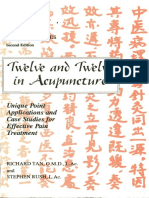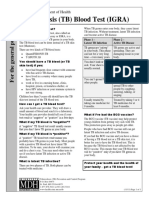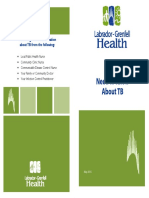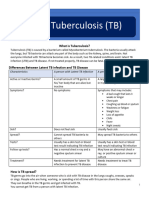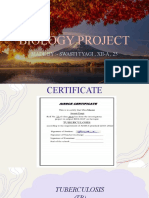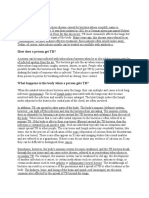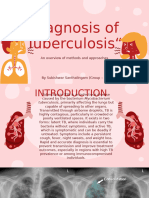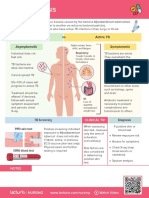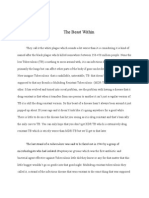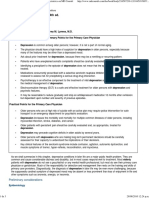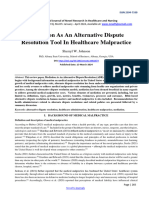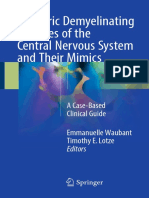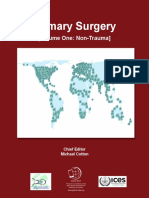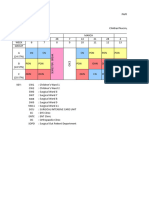Skin Testing Information
Skin Testing Information
Uploaded by
damozrocker333Copyright:
Available Formats
Skin Testing Information
Skin Testing Information
Uploaded by
damozrocker333Original Title
Copyright
Available Formats
Share this document
Did you find this document useful?
Is this content inappropriate?
Copyright:
Available Formats
Skin Testing Information
Skin Testing Information
Uploaded by
damozrocker333Copyright:
Available Formats
What You Need to Know About the TB Skin Test
Getting tested and treated for tuberculosis (TB)
can protect yourself, your family and friends,
and your community. There are two types
of tests for TB infection: the TB blood test
and the TB skin test. This fact sheet provides
information on the TB skin test.
TB Skin Test Tuberculosis
Bacteria
The TB skin test, also known as the tuberculin skin
test, may be used to find out if you are infected
with TB germs. A health care worker will use a small TB germs spread through
needle to inject testing fluid (called tuberculin) under
the air from one person to
the skin on the lower part of your inner arm.
another. Anyone can get TB.
TB germs usually attack the
After Receiving the TB Skin Test
lungs but can move to any
After the test, you should avoid using bandages,
putting on lotion, or scratching the test area part of your body.
because it may affect the results. You can wash
the area with water, but do not wipe or scrub. If The bacteria responsible
the area itches, put an ice cube or cold cloth on it. for causing TB can live in
the body for years without
After 2 or 3 days, you must return to have a health care worker
symptoms. This is called
read your skin test. You may have swelling or a bump where the
testing fluid was injected. The health care worker will measure the latent TB infection or inactive
bump or swelling and will tell you if your skin test reaction is TB. People with inactive
positive or negative. TB do not have signs and
symptoms of active TB
If you are not able to return within 2 to 3 days, you will need
to repeat the skin test again.
disease and cannot spread
TB bacteria to others.
Without treatment, inactive
Return to have your skin test read
TB can become active TB
Date:
disease at any time and
Time:
make you sick. If not treated
Location: properly, active TB disease
can be fatal.
Publication Number 301232 CS 339493-B August 07, 2023
If your skin test is POSITIVE: If your TB skin test is NEGATIVE:
• You have TB germs in your body. • Your body did not react to the test. You likely
• The test does not tell whether you have do not have inactive TB or active TB disease.
inactive TB or active TB disease. You • You may need to have more tests if:
will need other tests, such as a physical » You have symptoms of active TB
examination, chest x-ray, and lab work to disease, like coughing, chest pain,
determine if you have active TB disease. fever, weight loss, or tiredness.
• Once you test positive for TB, you will » You have HIV infection.
always have a positive skin test even if
you complete treatment for TB. Ask your » Your exposure to TB germs was recent.
health care provider for a written record of You may need a second skin test 8 to 10
your positive TB skin test result. This will be weeks after the last time you spent time
helpful if you are asked to have another test with someone with active TB disease. This
in the future. is because it can take several weeks after
infection for your immune system to react
to the TB skin test. If your reaction to the
second test is negative, you likely do not
have inactive TB or active TB disease.
Did You Receive the Bacille Calmette-Guérin (BCG) Vaccine?
BCG is a vaccine for TB. This vaccine is not widely used in the United States.
Many people born outside of the United States have received the BCG TB vaccine.
It is often given to infants and small children in other countries where TB is more
common. It protects children in those countries from getting severe forms of active
TB disease, such as TB meningitis. Protection from TB goes away as people get older.
Let your health care provider know if you were previously vaccinated
with the BCG TB vaccine.
In some people, the BCG TB vaccine may cause a positive TB skin test even if they are not infected with TB
germs. Unlike the TB skin test, TB blood tests are not affected by prior BCG vaccination. Therefore, TB blood
tests are the preferred test for people who have received the BCG TB vaccine.
TB Can Be Treated
If you have inactive TB, you can take medicine to prevent the development
of active TB disease even if you do not feel sick.
TB germs can live in your body for years without causing symptoms. Without
treatment, inactive TB can develop into active TB disease and make you sick.
If you have been diagnosed with active TB disease, you will need to take and
finish all your TB medicine. This is to help you feel better and prevent other
people from getting sick.
You might also like
- Richard Tan, OMD, LAc. Twelve and Twelve in AcupunctureDocument10 pagesRichard Tan, OMD, LAc. Twelve and Twelve in Acupunctureaa45% (11)
- Spanish Skintestinginformation 508Document2 pagesSpanish Skintestinginformation 508selena28mujicaNo ratings yet
- PP4 TuberculosisDocument43 pagesPP4 TuberculosisbjuniorndebeleNo ratings yet
- Tuberculosis (TB) Blood Test (IGRA) : Minnesota Department of HealthDocument1 pageTuberculosis (TB) Blood Test (IGRA) : Minnesota Department of HealthYeon Ae NaritaNo ratings yet
- IGRA-TB MN LAC EnglishDocument1 pageIGRA-TB MN LAC EnglishAdhimasRadityaNo ratings yet
- What You Need To Know About Tuberculosis: The Difference Between Inactive TB and Active TB DiseaseDocument2 pagesWhat You Need To Know About Tuberculosis: The Difference Between Inactive TB and Active TB DiseaseDescargar scribdNo ratings yet
- PP4 Tuberculosis 1453878076Document43 pagesPP4 Tuberculosis 1453878076khijogpNo ratings yet
- Tuberculosis: Tests and DiagnosisDocument3 pagesTuberculosis: Tests and DiagnosisArnie PengNo ratings yet
- Nonhealthcare EmployersDocument2 pagesNonhealthcare EmployersJanani SundarNo ratings yet
- What Is Tuberculosi: What Is The Difference Between Latent TB Infection and Active Disease?Document2 pagesWhat Is Tuberculosi: What Is The Difference Between Latent TB Infection and Active Disease?Koyel Sreyashi BasuNo ratings yet
- TB Booklet - May 2015Document8 pagesTB Booklet - May 2015fatimaNo ratings yet
- TuberculosisDocument2 pagesTuberculosisamr amerNo ratings yet
- What You Need To Know About The Tuberculosis Skin TestDocument8 pagesWhat You Need To Know About The Tuberculosis Skin Testdjprh tbdotsNo ratings yet
- Tuberculosis: by Rohma XI A2, Roll No.-2Document15 pagesTuberculosis: by Rohma XI A2, Roll No.-2fur ballNo ratings yet
- DefinitionDocument3 pagesDefinitionrahayusri yayuNo ratings yet
- Tuberculosis/General InformationDocument2 pagesTuberculosis/General InformationKatherine McNennyNo ratings yet
- Tuberculosis (TB) Presentation PDFDocument12 pagesTuberculosis (TB) Presentation PDFUday GuptaNo ratings yet
- Project 03 Pamplet Draft 02Document4 pagesProject 03 Pamplet Draft 02api-736439759No ratings yet
- What Are The Symptoms of TB?Document5 pagesWhat Are The Symptoms of TB?Reden Calubayan OblenaNo ratings yet
- TB AcknolwedgementDocument15 pagesTB AcknolwedgementradiciptaNo ratings yet
- Case Study TuberculosisDocument8 pagesCase Study TuberculosisCharisse SantillanNo ratings yet
- Tuberculosis TB - Johns Hopkins MedicineDocument9 pagesTuberculosis TB - Johns Hopkins Medicinearefayne wodajoNo ratings yet
- TB Fact Sheet - EnglishDocument2 pagesTB Fact Sheet - EnglishDescargar scribdNo ratings yet
- Testing For Tuberculosis (TB) : Tuberculin Skin Test (TST)Document2 pagesTesting For Tuberculosis (TB) : Tuberculin Skin Test (TST)Descargar scribdNo ratings yet
- What Is Tuberculosis (TB) ?: Patient EducationDocument2 pagesWhat Is Tuberculosis (TB) ?: Patient EducationBiniamNo ratings yet
- NATINAL TB PROG PHDocument83 pagesNATINAL TB PROG PHTherese PeñaNo ratings yet
- Teaching Plan For TBDocument5 pagesTeaching Plan For TBakritiNo ratings yet
- PBH 101 - Tuberculosis - SKMF-1Document15 pagesPBH 101 - Tuberculosis - SKMF-1Zahin KhanNo ratings yet
- TuberculosisDocument6 pagesTuberculosisomarmamluky254No ratings yet
- Biology Project: Made By:-Swasti Tyagi, Xii-A, 25Document18 pagesBiology Project: Made By:-Swasti Tyagi, Xii-A, 25Swasti TyagiNo ratings yet
- Tuberculosis TBDocument5 pagesTuberculosis TBHusna AmaliaNo ratings yet
- جمهوريه العراقDocument6 pagesجمهوريه العراقkhalifa90980No ratings yet
- Tory O: NameDocument17 pagesTory O: Namejana champakNo ratings yet
- Basic TB FactsDocument75 pagesBasic TB FactsFebrian Ivan PePeNo ratings yet
- Case Study On TBDocument3 pagesCase Study On TBJamil Lorca75% (8)
- TB Dots Treatment in The PhillippinesDocument8 pagesTB Dots Treatment in The Phillippinestmjrsvz84mNo ratings yet
- What Is TuberculosisDocument4 pagesWhat Is TuberculosisJonah Camille Yap FortunaNo ratings yet
- A View On TB ControlDocument30 pagesA View On TB ControlhonorinanuguidNo ratings yet
- Tuberculosis Taking ControlDocument9 pagesTuberculosis Taking Controlrkbhuvaneshwari32No ratings yet
- Viruses - Bacteria - Health 5th Sep, 2023Document27 pagesViruses - Bacteria - Health 5th Sep, 2023nazNo ratings yet
- Tuberculosis (TB)Document7 pagesTuberculosis (TB)shirsatharyan21No ratings yet
- Diagnosis of TB - Subishwar Santhalingam (GRP-F)Document20 pagesDiagnosis of TB - Subishwar Santhalingam (GRP-F)barcamagic2No ratings yet
- TuberculosisDocument4 pagesTuberculosisKate SantosNo ratings yet
- Sneezing: TransmissionDocument13 pagesSneezing: TransmissionMuzammal MollahNo ratings yet
- Causative Agent: Mycobacterium TuberculosisDocument20 pagesCausative Agent: Mycobacterium TuberculosisDivya TiwariNo ratings yet
- Reading TBC by Ananda ZusantyDocument24 pagesReading TBC by Ananda ZusantykhanzahastoNo ratings yet
- Nursing CS TuberculosisDocument1 pageNursing CS TuberculosisJazzmine GuraNo ratings yet
- Urinary Tract InfectionDocument20 pagesUrinary Tract InfectionFaraz SiddiquiNo ratings yet
- Tuberculosis (TB) PresentationDocument13 pagesTuberculosis (TB) PresentationNour El Houda MeghniNo ratings yet
- Tuberculosis (TB) PresentationDocument13 pagesTuberculosis (TB) PresentationAbdullahi Mahmud LafiamiNo ratings yet
- Tuberculosis (TB) PresentationDocument13 pagesTuberculosis (TB) PresentationSUNNY PARCHANo ratings yet
- The Beast Within: Corey Ortiz English 110 Brian Hendrickson September 10 2015Document5 pagesThe Beast Within: Corey Ortiz English 110 Brian Hendrickson September 10 2015Corey OrtizNo ratings yet
- TB - OutlineDocument11 pagesTB - Outlinekent yeeNo ratings yet
- Frequently Asked Questions On Tuberculosis (English) : Q: What Is Tuberculosis (TB) ?Document4 pagesFrequently Asked Questions On Tuberculosis (English) : Q: What Is Tuberculosis (TB) ?Mystery ShopperNo ratings yet
- TuberculosisDocument53 pagesTuberculosisDaniel Jayme100% (1)
- FAQ About Summit County TB InvestigationDocument5 pagesFAQ About Summit County TB InvestigationWKYC.comNo ratings yet
- I and I 4Document10 pagesI and I 4Sahara Sahjz MacabangunNo ratings yet
- Lecture Notes TuberculosisDocument6 pagesLecture Notes TuberculosisDENNIS N. MUÑOZ100% (1)
- TB PamphletDocument2 pagesTB PamphletMuhammad Kamal0% (1)
- Fast Facts for Patients and their Supporters: Inflammatory Bowel Disease: Ulcerative Colitis and Crohn's DiseaseFrom EverandFast Facts for Patients and their Supporters: Inflammatory Bowel Disease: Ulcerative Colitis and Crohn's DiseaseNo ratings yet
- A Simple Guide to Toxic Shock Syndrome, Diagnosis, Treatment and Related ConditionsFrom EverandA Simple Guide to Toxic Shock Syndrome, Diagnosis, Treatment and Related ConditionsNo ratings yet
- NARAYANA Project WorkDocument102 pagesNARAYANA Project Worknaveen chitiralaNo ratings yet
- Acupressure Points For Knee PainDocument7 pagesAcupressure Points For Knee Painلوليتا وردةNo ratings yet
- Biomedical EngeniringDocument6 pagesBiomedical EngeniringGeneration GenerationNo ratings yet
- C6-L2 Privitera, M. y Lyness, J. (2007) - Depression. en Duthie Practice of Geriatrics (4a Edición) .Document3 pagesC6-L2 Privitera, M. y Lyness, J. (2007) - Depression. en Duthie Practice of Geriatrics (4a Edición) .CATALINA MALDONADO GALLEGUILLOSNo ratings yet
- AMR Manual WHO Input (Optional)Document18 pagesAMR Manual WHO Input (Optional)Saltuk KoçyiğitNo ratings yet
- Mediation As An Alternative Dispute Resolution Tool in Healthcare MalpracticeDocument10 pagesMediation As An Alternative Dispute Resolution Tool in Healthcare MalpracticeNovelty JournalsNo ratings yet
- HMO Presentation 2022-2023 RankFile PROBATIONARYDocument37 pagesHMO Presentation 2022-2023 RankFile PROBATIONARYArnie PalerNo ratings yet
- Diabetes Leader 2019 PDFDocument12 pagesDiabetes Leader 2019 PDFArjun Kumar AdhikariNo ratings yet
- Pediatric Demyelinating Diseases of The Central Nervous System and Their MimicsDocument338 pagesPediatric Demyelinating Diseases of The Central Nervous System and Their MimicsVu Hoang100% (1)
- Medicare Home Health Face To Face Requirement PowerpointDocument12 pagesMedicare Home Health Face To Face Requirement Powerpointbobjones3296No ratings yet
- Miasma SicozaDocument13 pagesMiasma SicozaminunatNo ratings yet
- Idiopathic Thrombocytopenic PurpuraDocument10 pagesIdiopathic Thrombocytopenic Purpuramariakolanda100% (1)
- 1rst Seminar Pulpal Diseases WORDDocument15 pages1rst Seminar Pulpal Diseases WORDNikita KamatNo ratings yet
- Help PrimarysurgeryDocument881 pagesHelp PrimarysurgeryEzio Auditore da FirenzeNo ratings yet
- Case Report Uterine InversionDocument64 pagesCase Report Uterine InversionFelicia Yumita Winata100% (1)
- Hypertension: Several Readings of High Blood Pressure, Thus Its Other NameDocument41 pagesHypertension: Several Readings of High Blood Pressure, Thus Its Other NameSophie Rose V R-zNo ratings yet
- Soal + Pembahasan - Epilepsy and Seizure - 2Document2 pagesSoal + Pembahasan - Epilepsy and Seizure - 2jumasriNo ratings yet
- Medical Terminology Learning Outcome 1: Apply The Rules For Construction and Analysis of Medical TermsDocument15 pagesMedical Terminology Learning Outcome 1: Apply The Rules For Construction and Analysis of Medical TermsSuzan MatarNo ratings yet
- Traditional Medicinal Uses and Therapeutic Benefits of Momordica Charantia LinnDocument6 pagesTraditional Medicinal Uses and Therapeutic Benefits of Momordica Charantia Linnjuan mezaNo ratings yet
- Treatment of Raised ICP PDFDocument8 pagesTreatment of Raised ICP PDFRoy Andrew LiemNo ratings yet
- Hypovolemic ShockDocument29 pagesHypovolemic ShockGlyssa CabarrubiasNo ratings yet
- DocxDocument99 pagesDocxVanessa AbboudNo ratings yet
- Clinical StudentDocument10 pagesClinical StudentHazimah Haji SuhipNo ratings yet
- Ergogenic Aids A Review of Basic Science, Performance, Side Effects, and Status in Sports PDFDocument11 pagesErgogenic Aids A Review of Basic Science, Performance, Side Effects, and Status in Sports PDFRuben CapelaNo ratings yet
- Teaching Plan Fo Cord Car1Document15 pagesTeaching Plan Fo Cord Car1jaden1233No ratings yet
- UntitledDocument8 pagesUntitledAman KhanNo ratings yet
- Mcu Hospital - Filemon D. Tanchoco Foundation: Clinical Internship 2022 E-PortfolioDocument2 pagesMcu Hospital - Filemon D. Tanchoco Foundation: Clinical Internship 2022 E-PortfolioAngelica Joy GonzalesNo ratings yet
- Collins 679 Assignment 1Document7 pagesCollins 679 Assignment 1api-456681075No ratings yet
- Evidence Based Management of Low Back Pain 1e 1st Edition Simon Dagenais CD PHDDocument84 pagesEvidence Based Management of Low Back Pain 1e 1st Edition Simon Dagenais CD PHDvuncsyosyNo ratings yet
